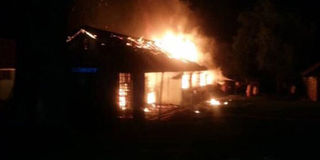Rampant fires in schools worrying

Malaria continues to pose the highest public health challenge to Ugandans, causing significant ill-health and deaths. As a consequence, it leads to enormous economic losses. It also affects the under five-year-old children and the school going age children.
The Ministry of Health in collaboration with Ministry of Education developed a policy to distribute long-lasting insecticide treated nets through schools in 2014 with support from the American Government (USAID’s Malaria Action Programme for Districts (MAPD) covering 22 districts.
Ministry of Health, which initiated and executed the project is commended. As part of the school malaria prevention programme, teachers and parents were advised to encourage their children to use mosquito nets while in boarding schools and at home. Insecticide-treated nets have been proved to be quite effective intervention against malaria by World Health Organisation (WHO).
It is commendable that the Ministry of Education explored the opportunity to work with private sector as part of public-private partnership approach to support Ministry of Health to facilitate Ugandan children access WHO approved insecticide-treated nets.
The insecticide-treated nets provide double protection - one as a fabric barrier, and the other as the insecticide that kills the mosquitoes.
Once this strategy has been fully embraced by all stakeholders, improvement in school enrolment, attendance and reduced absenteeism due to malaria will be remarkable.
However, it has been unfortunate that the Ministry of Health decided to procure the type of nets that are made from petroleum by-products called polyethylene compound that is highly inflammable.
Olyst net is made from polyethylene products, which include polythene bags (Kaveeras) and many other plastics. No wonder that fires are rampant in boarding schools and in family houses that are also used for cooking. The type of nets that have been distributed in schools are called Olyset and are manufactured from petroleum by-products hence easily catch fire.
Where is the likely source of fire? Families which sleep in houses that are at the same time being used as cooking places would be highly prone to fires from olyset nets. In the case of boarding schools, it is known that during electricity loadsheding, particularly noticed during the nights, students resort to use of candles and lanterns.
Are there other alternatives of insecticide-treated nets (ITNs)?. Yes there are other alternative nets that are made of cotton called polyester nets, Yakool and Permanent nets both approved by WHO.
Therefore, I appeal to all Ugandans who sleep in houses which at the same time serve as cooking places never to use polyethylene Olystet nets and Duranet) nets in order to avoid fires destroying their homes.




